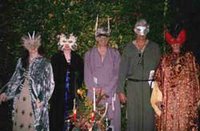Friday, November 25, 2005
Esbats
Most meetings are held at the Covenstead but during the summer months can be held beside our local river and sea shores.
Note the position of the Full Moon and you will then know that we are celebrating Esbat.
For more information go to our Esbat pages
Thursday, November 24, 2005
Rituals

Ceremonies and rituals have always played a major part in human life, whether they are rites of passage, as a child is born, puberty passes, a birthday party, when couples marry or we move on to new worlds. They are all intended to impress and influence, and should leave a lasting impression, strongly influencing people to reinforce or change their lives, and within themselves to alter assumptions, attitudes and expectations.
All religions rely upon ritual to reinforce doctrine and belief, and ceremonies can often be very lavishly ritualistic, as in the election of a new Pope in the Catholic church, or prolonged and involving the entire population as in Ramadan, a special month in Islam, a time for inner reflection, devotion to God, and self-control.
To be effective any ritual must have a strong beginning and ending. Often drums, whistles or trumpets are used to obtain people’s attention. Similarly the ending must be clearly defined. Too often these distinctions are not made, and ritual becomes blurred into everyday life, and loses its significance and diminishes in importance. The blessing of food before eating a meal is often garbled and indistinct, a ritual that has now lost its significance for many people.
It must involve your senses. It may be interesting or beautiful but it will be enhanced if there is music, or incense, and movement. It should also involve the audience, with joint responses from them all or small parts for each individual to play.
There should not be too many surprises. It should follow a predictable form, so the audience feels comfortable and relaxed. Cohesiveness is important, particularly for religious groups with a wide membership, as each member knows what to expect, wherever the ritual may be held.
Each part of the ritual must be clearly understood by the participants. Another world may be addressed however those in this world must know what is happening. Explanations should be given before the start and at the end of the ritual to ensure that everyone knows what will and has taken place.
Clearly any ritual must be special. Too many of our public holidays have now lost their significance, often in a wave of commercialism, and as a result the whole concept of joining together in celebration or to mark an event in our lives has fallen into decline.
A special area should be set aside for the ritual. It could be consecrated, with a blessing dedicated to the area to bring protection, or good fortune. A circle of people holding hands creates a special place. In our coven our High Priest and High Priestess have devoted part of their garden to the circle. This not only provides a permanent place, which is convenient, private and free from disturbance but the value of the circle is enhanced as the memories of each ritual are imprinted both on the surroundings and the participants.
Clothing should be reserved for the ritual, and only worn on such occasions. To that may be added other objects, an altar, bowls, flowers, banners, crystals, statues – all can serve to make the ritual special. In the coven we all have special clothing, often wearing different robes for each sabat, and the altar and accoutrements used each time have been created solely for use in that ritual.
Movements and gestures that are rarely made at other times can also serve to set the ritual apart from ordinary life, perhaps a dance, a genuflection, all will enhance the significance of the ritual.
Rituals are very important, and can be found in all parts of our lives. A morning assembly in a school and a funeral, both are rituals. They each follow the principles described, and we gain from the spirit of comradeship as we gather together to perform such ceremonies.
![Validate my Atom 0.3 feed [Valid Atom 0.3]](http://www.braiswick.com/graphics/valid-atom.png)
Tuesday, November 22, 2005
Useful Contacts

It will take time, but we will slowly build our web site into an extremely informative place for pagans.
One small start is a page of useful contacts. These are maintained by Furl , a useful service, and part of our list of web sites that may be of some use to pagans is displayed on our Contacts page and the rest can be found by clicking through to our complete Furl list, where you can add your own comments.
This photograph was takenat Mabon, it shows five of the principals in that ceremony. The web site will soon have more information about this ritual, which takes place at the autumn equinox, September 21st.
Monday, November 21, 2005
Sabats
Next will come Yule, the heart of winter, at the winter solstice, at 21 December.
In February, at Candlemass is Imbolg, the passing of winter.
Ostara is the rite of Spring at the vernal equinox, about 21 March.
Then comes Beltane when the God and Goddess join together in fecund union.
Litha or the midsummer solstice has the Goddess blooming at the height of summer, usually held on 21 June, as we move on to
Lughnasadh, in August, as the first fruits of harvest are gathered in,
with Mabon to follow at the autumnal equinox, around 21 September, and so the circle completes with
Samhain again, when we look back over the past year, and after reflection, start to plan for the coming seasons.
Saturday, November 19, 2005
Principals
Thursday, November 17, 2005
Welcome
Come with us on a journey of discovery as we explore and explain our world. Our web site is at www.carlfordcoven.co.uk

